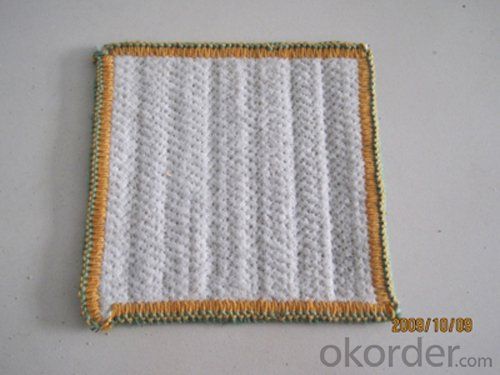Geosynthetic Clay Layer for River bank and landfill projects
- Loading Port:
- Tianjin
- Payment Terms:
- TT OR LC
- Min Order Qty:
- -
- Supply Capability:
- 5000rolls m²/month
OKorder Service Pledge
OKorder Financial Service
You Might Also Like
Geosynthetic Clay Layer for River bank and landfill projects
Made from two layers geotextile with natural sodium in the centre
Specification of Geosynthetic Clay Layer for River bank and landfill projects:
I. GCL-NP; GCL-OF; GCL-AH
2. Unit weight: >4000G/M2
3.4m - 6m in roll width
Property of Geosynthetic Clay Layer for River bank and landfill projects:
I. Swell when meet water
2. Long time waterproofing and friendly to environment
3. Separation, reinforcement, protection, filtration and easy for construction
Application of Geosynthetic Clay Layer for River bank and landfill projects
:
I. Municipal project, subway, underground and roof waterproofing
2. Landfill, waste water treatment, industrial waste
3. Waterproofing and reinforcement in water conservancy, riveC lake and dam
4. Artificial lake, golf course and fish pond
5. Petrifaction and mineral waterproofing
Production Standards of Geosynthetic Clay Layer for River bank and landfill projects:
JC/T193-2006
- Q:GB waterproof geotextile what price
- The price of Guobao waterproof geotextile is calculated according to the weight per square meter. For more information, please contact us.
- Q:What are the advantages of using geotextiles in green building design?
- Geotextiles offer numerous advantages in green building design. Firstly, they provide effective erosion control by stabilizing soil, preventing sediment runoff, and reducing the need for traditional erosion control measures. Additionally, geotextiles enhance water filtration and drainage, promoting healthier soil and preventing waterlogging. These materials also aid in weed control, reducing the need for herbicides and minimizing maintenance efforts. Moreover, geotextiles can improve the structural integrity of green building projects by reinforcing soil and preventing subsidence. Lastly, they offer a sustainable solution as they are typically made from recycled materials and can be reused or recycled themselves.
- Q:Planting roofing geotextile lap way
- Lap 10 cm, sewing with sewing machine, I specializing in the production of roofing with geotextile, drainage board and other products, wish smooth
- Q:What are the different geotextile installation guidelines?
- The different geotextile installation guidelines include proper site preparation, ensuring the soil is smooth and free of debris, anchoring the geotextile securely to prevent movement, overlapping the geotextile to ensure complete coverage, and using appropriate techniques for joining and sealing the geotextile. Additionally, it is crucial to follow manufacturer instructions and consult with an engineer for specific project requirements.
- Q:Manufacture of geotextile machinery
- Non-woven needle machine, I am specializing in the production of geotextiles
- Q:Are geotextiles recyclable?
- Yes, geotextiles are recyclable.
- Q:How do geotextiles help with pipeline protection?
- Geotextiles help with pipeline protection by acting as a barrier between the pipeline and the surrounding soil. They prevent soil particles from infiltrating the pipeline, which can cause corrosion and damage. Geotextiles also provide stability and support to the pipeline, reducing the risk of settlement and potential structural failures. Additionally, they aid in filtration by allowing water to pass through while retaining soil particles, ensuring proper drainage and preventing clogging of the pipeline.
- Q:What is the representative batch of geotextile?
- Geotextile batch is 2000 square meters.
- Q:Are geotextiles resistant to creep deformation?
- Yes, geotextiles are generally resistant to creep deformation. Geotextiles are designed to have high tensile strength and low creep properties, allowing them to withstand long-term loads and maintain their original shape and dimensions over time.
- Q:What are the different geotextile testing methods?
- There are several different geotextile testing methods, including but not limited to, grab tensile strength testing, puncture resistance testing, tear resistance testing, burst strength testing, and permeability testing. These methods help assess the physical properties and performance of geotextiles in various applications.
1. Manufacturer Overview |
|
|---|---|
| Location | |
| Year Established | |
| Annual Output Value | |
| Main Markets | |
| Company Certifications | |
2. Manufacturer Certificates |
|
|---|---|
| a) Certification Name | |
| Range | |
| Reference | |
| Validity Period | |
3. Manufacturer Capability |
|
|---|---|
| a)Trade Capacity | |
| Nearest Port | |
| Export Percentage | |
| No.of Employees in Trade Department | |
| Language Spoken: | |
| b)Factory Information | |
| Factory Size: | |
| No. of Production Lines | |
| Contract Manufacturing | |
| Product Price Range | |
Send your message to us
Geosynthetic Clay Layer for River bank and landfill projects
- Loading Port:
- Tianjin
- Payment Terms:
- TT OR LC
- Min Order Qty:
- -
- Supply Capability:
- 5000rolls m²/month
OKorder Service Pledge
OKorder Financial Service
Similar products
New products
Hot products
Hot Searches
Related keywords





























